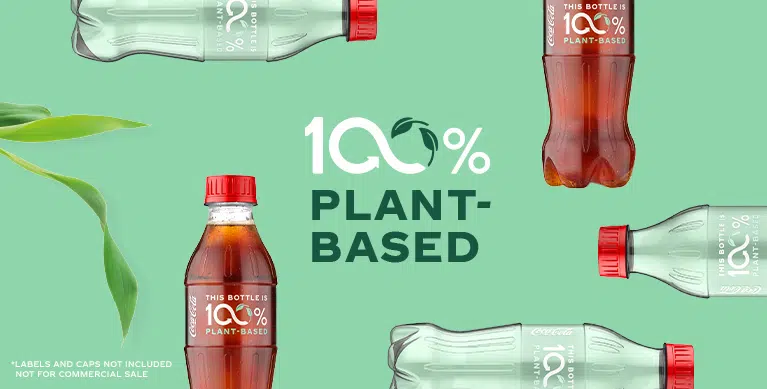It is no secret that the world is overwhelmed by a plastic problem. Photos of the Pacific Garbage Patch are ubiquitous in the media, and research on microplastics in our food and bodies regularly flood news outlets. Campaigns on cleaning our oceans and efforts to reduce plastic waste have exploded in popularity in recent years. As a response to this issue, corporations have begun to roll out what they claim are more sustainable plastics as a solution to the public’s demand for action.
Coca-Cola recently announced that they are switching packaging of their single-use plastics to a 30% plant-based polyethylene terephthalate, or PET. The plastic is said to be greener, as it has a lower carbon footprint from its higher percentage of plant matter as opposed to fossil fuels. Additionally, as it is easier to recycle than other plastics, PET can have a new life after being treated and processed. This means that a higher percentage of these single-use plastics can be recycled, rather than ending up in landfills. Yet, if the PET bottles are not recycled and end up in landfills or waterways, they are not able to biodegrade and can remain in these systems for nearly 450 years. Nevertheless, recycling products has a high carbon footprint, as it requires a lot of energy, which in today’s world is unfortunately still obtained by the burning of fossil fuels.
Another commercially sustainable plastic option is biodegradable or compostable plastics. These plastics are not made from fossil fuels, but rather from renewable biomass sources such as vegetable oils, saw dust, wood chippings, and other similar materials. This allows for a much lower carbon footprint compared to other plastics—though it is important to note that these are still carbon-based and will release carbon dioxide if burned or degraded at a rapid rate. Another benefit to these plastics is that they are made from renewable sources, rather than finite and more outwardly harmful resources such as oil. The foremost (and most marketable) benefit of using these plastics is that they are biodegradable and compostable; however this aspect may not be as positive as one may expect.
Compostable plastics must be industrially composted, which means one cannot simply compost their single-use utensil in their at-home compost bin. Additionally, composting may prove to be more difficult in some households where curbside pickup is not available. This means compostable goods need to be brought to the location by someone in the household, rather than having them picked up like recycling or trash. People may also not know that biodegradable plastics are unable to be recycled, and they may try to mix them with other recyclables. When this happens, the batch of recycling is oftentimes not sorted and treated properly, leading to the whole batch being incinerated.
Further consequences of this inaccessibility come to light when one considers the ‘green’ branding of these bioplastics. Many people believe that because they can technically be composted and are biodegradable that it does not matter if they are not contained (for example, they are simply left in grass fields, parking lots, or waterways). This can actually increase the amount of litter and plastic wastes in our ecosystems if users are not properly educated on what ‘biodegradable’ actually means for industrial use plastics.
Overall, although bioplastics have a lower carbon footprint, they do not solve all problems associated with heavy plastic use, such as marine litter. Additionally, they are more difficult to dispose of than other products and can cause increases in waste in aquatic and terrestrial ecosystems. In terms of reducing waste, highly recyclable plastics such as PET may be a better alternative while the world still has such a high demand for single-use plastic materials.
The surplus of problems that still exist in spite of sustainable plastics leads one to question whether the type of plastic itself is truly the issue at hand. At the end of the day, the solution to the world’s plastics problem is simple: drastically reduce the number of single-use plastics in circulation. Using less is a better alternative to single-use items, regardless of how sustainable the product is, or is branded to be. When the consumption of single-use plastics is reduced, there is a diminished need to recycle products and less opportunity for waste to end up in natural spaces.
If corporations truly want to decrease their environmental impact and transition to more sustainable practices, decreasing their overall production of single-use items is the principal step. Ultimately, it does not matter how sustainable or recyclable a plastic bottle is if it ultimately becomes a pollutant at the end of its life cycle. The true solution to this problem is a reduction in the consumption of single-use and disposable products in our everyday lives.
Sources
“Which Is Better for the Environment: Compostable Bioplastics or Pet? The Answer May Surprise You.” Plasticstoday.com, 7 July 2020, https://www.plasticstoday.com/packaging/which-better-environment-compostable-bioplastics-or-pet-answer-may-surprise-you.
“Bottles Made from 100% Plant Plastic.” The Coca-Cola Company, https://www.coca-colacompany.com/news/100-percent-plant-based-plastic-bottle.
“Fossil-Based vs. Bio-Based Pet Plastic Bottles.” TricorBraun, 9 Dec. 1970, https://www.tricorbraun.com/sustainability-times-newsletter/volume-10/issue-2/.
Ritchie, Hannah, and Max Roser. “Plastic Pollution.” Our World in Data, 1 Sept. 2018, https://ourworldindata.org/plastic-pollution#:~:text=The%20world%20now%20produces%20more,our%20natural%20environment%20and%20oceans.
Featured image from coca-colacompany.com/news/100-percent-plant-based-plastic-bottle(opens in a new tab)

